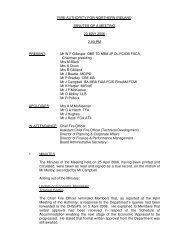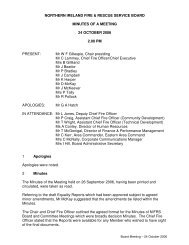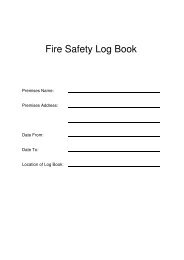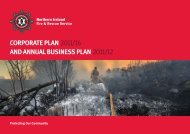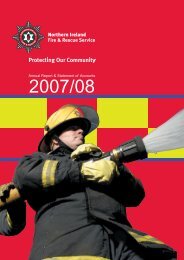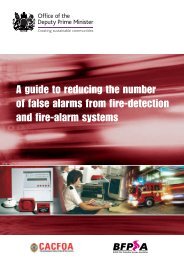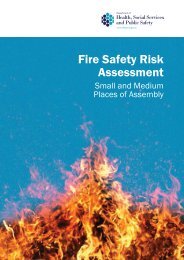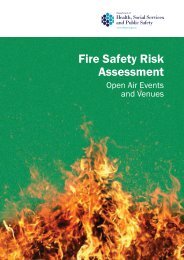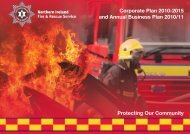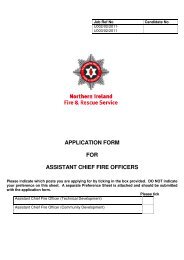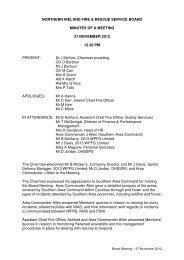Fire Safety Law - Are you aware of your responsibilities - Northern ...
Fire Safety Law - Are you aware of your responsibilities - Northern ...
Fire Safety Law - Are you aware of your responsibilities - Northern ...
- No tags were found...
Create successful ePaper yourself
Turn your PDF publications into a flip-book with our unique Google optimized e-Paper software.
CONTENTSPurpose <strong>of</strong> this guidance booklet 1What has changed? 2<strong>Fire</strong> safety risk assessment explained 3Managing fire safety 7What are <strong>you</strong>r rights and <strong>responsibilities</strong>? 10Who enforces the law? 13Frequently asked questions 15Issues which should be considered as part <strong>of</strong> <strong>you</strong>r fire 18safety risk assessmentWhat guidance is available? 22
Step 3: Evaluate the risk and decide if existing fire safety measuresare adequateThe premises should be critically examined to identify any potential accidents and any actsor omissions which might allow a fire to start. This should include possible opportunities fordeliberate ignition.Having considered the chances <strong>of</strong> a fire starting and the people likely to be at risk should afire start in the building, the extent <strong>of</strong> the actual risk to those people must be considered.In evaluating the risk to people thought should be given to how and where the fire mayspread and how this may affect escape routes.<strong>Fire</strong> safety law requires that the following principles must be considered when implementingfire safety measures:• Avoiding risks;• Evaluating risks which cannot be avoided;• Combating risks at source;• Adapting to technical progress;• Replacing the dangerous with the non-dangerous or less dangerous;• Developing a coherent fire prevention policy which covers technology, organisation <strong>of</strong>work and the influence <strong>of</strong> factors relating to the working environment;• Giving collective fire safety protective measures priority over individual measures; and,• Giving appropriate instruction to employees.Having identified the fire hazards in Step 1, the risks should be avoided by removing orreducing sources <strong>of</strong> ignition, fuel and oxygen. If the hazards cannot be removed, measuresshould be taken to reduce the risks. <strong>Fire</strong> safety measures should be put in place to reducethe likelihood <strong>of</strong> fire and spread <strong>of</strong> fire; to provide means <strong>of</strong> escape; to fight fire; to detectfire and give warning; arrange for action in the event <strong>of</strong> fire; and for training.Step 4: Record fire safety risk assessment informationHaving carried out a fire safety risk assessment in relation to the premises, the findings mayneed to be recorded. <strong>Fire</strong> safety law requires information to be recorded in cases where4
there are five or more employees (whether they are on site or not), or the premises aresubject to licensing or registration, or an alterations notice has been issued requiring this.While it is not a legislative requirement for some, it is best practice for all premises to recordthe findings <strong>of</strong> their Risk Assessment.Where information is required to be recorded, the following should be included:• The significant findings, if any, from the fire safety risk assessment;• The resulting fire safety measures and action to be taken;• Persons who are especially at risk; and• <strong>Fire</strong> safety arrangements for the effective planning, organisation, control, monitoring andreview <strong>of</strong> the fire safety measures.Any information recorded should be available for inspection by the enforcing authority.Step 5: Review <strong>of</strong> fire safety risk assessmentA review <strong>of</strong> the fire safety risk assessment should be carried out regularly. It should occur ifthe findings <strong>of</strong> the fire safety risk assessment are considered to be no longer valid or therehas been a significant change to the premises, or the organisation <strong>of</strong> the work undertakenhas affected the fire risk or the fire safety measures.Situations which might prompt a review include:• A change in the number <strong>of</strong> people present or the characteristics <strong>of</strong> the occupantsincluding the presence <strong>of</strong> people with some form <strong>of</strong> disability;• Changes to work procedures, including the introduction <strong>of</strong> new equipment;• Alterations to the building, including the internal la<strong>you</strong>t;• Significant changes to displays or quantities <strong>of</strong> stock;• The introduction or increase in the storage <strong>of</strong> hazardous substances;• Becoming <strong>aware</strong> <strong>of</strong> shortcomings or potential improvements; or• A fire occurrence.5
The potential risk <strong>of</strong> any proposed change should be considered before the change isintroduced. If a change introduces new hazards, consider the fire risk and, if significant, dowhatever is needed to keep the risks under control. In any case the assessment should bekept under review to make sure that the fire safety measures remain adequate.If a fire or near miss occurs, this could indicate that the existing assessment may beinadequate and a re-assessment should be carried out. Identify the cause <strong>of</strong> any incident,then review and, if necessary, revise the outcome <strong>of</strong> the fire safety risk assessment in thelight <strong>of</strong> this experience.A list <strong>of</strong> issues which should be considered as part <strong>of</strong> the fire safety risk assessmentis at the rear <strong>of</strong> this booklet. Please note, however, that this is not intended to be acomprehensive list.6
MANAGING FIRE SAFETYA management commitment to fire safety is essential to assist with achieving suitable firesafety standards in premises and to maintain a culture <strong>of</strong> fire safety.There should be a clearly defined fire safety policy to protect all those using the premisessuch as residents, staff and visitors which should include arrangements for planning,organisation, control, monitoring and review <strong>of</strong> fire safety measures.It is a management responsibility to have in place both an emergency fire action plan andarrangements to implement the plan. A written emergency fire action plan should be kepton the premises, be available to and known by staff and form the basis <strong>of</strong> the trainingand instruction which is provided. This plan should be available for inspection by theenforcing authority.The purpose <strong>of</strong> the emergency fire action plan is:• To ensure that people on the premises know what to do if there is a fire; and,• To ensure that appropriate action is taken in the event <strong>of</strong> fire and that the premises canbe safely evacuated.The results <strong>of</strong> the fire safety risk assessment(s) must be considered when drawing up theemergency fire action plan, alongside procedures for all those occupying the premisesincluding people with disabilities.In care and institutional premises, the capability and dependency <strong>of</strong> occupants isparamount when determining suitable procedures, actions and fire safety measures to meettheir personal evacuation needs. In other premises, the requirements <strong>of</strong> any staff memberwith disabilities or person with disabilities who frequently uses the premises should bediscussed and agreed with the individual. A personal emergency egress plan for each <strong>of</strong>these persons should be established and should contain details <strong>of</strong> special evacuationarrangements.The evacuation <strong>of</strong> all persons, including people with disabilities, from the premises is theresponsibility <strong>of</strong> those persons with control <strong>of</strong> the premises. It cannot be delegated to the<strong>Fire</strong> and Rescue Service. Appropriate arrangements should be made to ensure that thepremises can be fully evacuated if necessary. It is not appropriate to move people withdisabilities to internal holding points for evacuation by the <strong>Fire</strong> and Rescue Service.7
It is essential that staff know what they have to do to safeguard themselves and others onthe premises and to have an <strong>aware</strong>ness <strong>of</strong> the importance <strong>of</strong> their actions. This includesrisk reduction, maintenance <strong>of</strong> fire safety measures and action if there is a fire.All staff (including temporary and agency staff) should be given information, training andinstruction on the fire safety measures to be taken or observed on the premises, includingthe action to be taken in case <strong>of</strong> fire. Where appropriate, staff should receive training onphysically assisting people during an evacuation and should know how to use any aids orequipment provided for this purpose.All training should complement the emergency fire action plan, be verifiable and beevidenced by management records. <strong>Fire</strong> safety training should be specific to the premisesand should include the following:• The action to take on discovering a fire;• How to raise the alarm and what happens then;• The action to take upon hearing the fire alarm;• Instruction on the operation <strong>of</strong> any fire alarm control panel installed within the building,paying particular attention to the information displayed and its interpretation;• The significant findings <strong>of</strong> the fire safety risk assessments;• The measures that have been put in place to reduce the risk from fire;• The identity <strong>of</strong> people nominated with <strong>responsibilities</strong> for fire safety;• Any special arrangements for serious and imminent danger to persons from fire;• The procedures for alerting visitors and members <strong>of</strong> the public including, whereappropriate, directing them to exits;• The arrangements for calling the <strong>Fire</strong> and Rescue Service;• The measures in place to ensure a safe escape from the building and how they willoperate;• The personal emergency egress plans for people with disabilities;• The evacuation procedures for everyone in the building to reach an assembly point at asafe place;8
• The fire prevention and fire safety measures and procedures in the premises and wherethey impact on staff and others in the building;• The location and, where appropriate, the use <strong>of</strong> fire-fighting equipment;• The location <strong>of</strong> the fire escape routes, especially those not in regular use;• How to open all escape doors, including the use <strong>of</strong> any special fastenings;• The importance <strong>of</strong> keeping fire doors closed to prevent the spread <strong>of</strong> fire, heat andsmoke;• The reason for not using lifts (except those specifically designed or designated forevacuation use);• The importance <strong>of</strong> good housekeeping;• The risks from flammable materials used or stored on the premises;• The precautions to be taken to minimise and control the risks, with particular attentionto their role in reducing and controlling fuel and ignition sources; and,• How to stop any machines and processes or isolate power supplies, where necessary, inthe event <strong>of</strong> a fire.<strong>Fire</strong> drills should be carried out to check that staff understand the emergency fire actionplan (including all relevant personal emergency egress plans), to ensure that staff arefamiliar with its operation, to evaluate the effectiveness <strong>of</strong> the plan and to identify anyweaknesses in the evacuation strategy.The frequency and type <strong>of</strong> fire evacuation drill for each premises will be different and shouldreflect the type <strong>of</strong> premises and level <strong>of</strong> risk. A check should be made to establish if anypeople are unaccounted for, possibly by carrying out a roll call at the designated assemblypoint(s). In a fire evacuation this information would need to be passed to the <strong>Fire</strong> andRescue Service on their arrival.The premises, emergency routes and exits, fire-fighting equipment, fire alarm, emergencylighting and other fire safety measures should be kept in efficient working order andcovered by a suitable system <strong>of</strong> maintenance. There should be regular checks, periodicservicing and maintenance, such as a daily check that means <strong>of</strong> escape are available andunobstructed; a weekly test <strong>of</strong> the fire alarm system; a monthly test <strong>of</strong> emergency lightingsystems; and an annual service <strong>of</strong> fire extinguishers. Any defects should be put right asquickly as possible.9
WHAT ARE YOUR RIGHTS ANDRESPONSIBILITIES?The following is a summary <strong>of</strong> the main rights and <strong>responsibilities</strong> <strong>of</strong> those covered bythe legislation. For a comprehensive list <strong>of</strong> <strong>you</strong>r rights and <strong>responsibilities</strong>, please referto the legislation. If <strong>you</strong> have any doubts about <strong>you</strong>r legal obligations, <strong>you</strong> should seekindependent legal advice.As an employer:• You are entitled to the co-operation <strong>of</strong> <strong>you</strong>r employees in respect <strong>of</strong> <strong>you</strong>r fire safety<strong>responsibilities</strong> and for employees to take reasonable care for their own safety andothers whom their actions could affect.• You must carry out (and review regularly) a fire safety risk assessment to identify thepotential for fire to occur in the workplace and cause harm to employees and otherpersons in, or in the immediate vicinity <strong>of</strong>, the premises.• You must ensure so far as is reasonably practicable, the safety <strong>of</strong> <strong>you</strong>r employees fromharm caused by fire in the workplace and take reasonable measures to ensure theirsafety and that <strong>of</strong> others there, or in the immediate vicinity. These measures should beaimed at avoiding or reducing any risks identified.• You must provide clear, appropriate information and instruction (and training wherenecessary) to <strong>you</strong>r employees and anyone else working on <strong>you</strong>r premises, e.g.contractors and their employer(s), in relation to any risks identified and fire safetymeasures provided.• You must ensure that a record <strong>of</strong> a fire safety risk assessment is kept (electronicallyor paper-based) if <strong>you</strong> employ five or more employees (whether they are based in thepremises or not), have a licence (such as a liquor licence) for the premises, are subject toregistration (such as care home registration), or an alterations notice requiring this hasbeen served in relation to the premises by the enforcing authority.• You must carry out (or review) a fire safety risk assessment before employing anyoneunder the age <strong>of</strong> 18, taking into account their <strong>you</strong>th and inexperience, and the particularrisks they may be exposed to in the workplace. If a child is <strong>of</strong> school age, their parentmust be informed <strong>of</strong> the risks and the measures taken to avoid or reduce them.• You must ensure that the premises are equipped to an appropriate level, with means <strong>of</strong>escape (ensuring these can be safely used); means <strong>of</strong> detecting fire and giving warningin the event <strong>of</strong> fire; means <strong>of</strong> fighting fires; and arrangements for action to be taken inthe event <strong>of</strong> fire.• You must ensure that the premises, and any fire safety facilities, equipment and devicesare maintained in good order.10
• You must co-operate with anyone else who has fire safety <strong>responsibilities</strong> in respect<strong>of</strong> the same premises (including sharing information about the activities/measuresundertaken, where appropriate) and take all reasonable steps to co-ordinate <strong>you</strong>r firesafety measures regarding the premises.As an employee:• You are entitled to the provision <strong>of</strong> adequate fire safety measures on the premises toensure, as far as is reasonably practicable, <strong>you</strong>r safety from harm caused by fire.• You are entitled to appropriate instruction (and training where necessary) about anyrisks identified on the premises, fire safety measures provided and what to do in theevent <strong>of</strong> a fire.• You must take reasonable care to ensure the workplace is safe from harm caused by fireand do nothing that will place <strong>you</strong>rself or others at risk.• You must inform <strong>you</strong>r employer (or a fellow employee with specific fire safety<strong>responsibilities</strong>), <strong>of</strong> anything relating to the premises which could represent aserious and immediate fire safety danger; <strong>of</strong> anything which <strong>you</strong> reasonably considerrepresents a shortcoming in the employer’s fire safety protection arrangements; or inthe event <strong>of</strong> fire.• You must co-operate with <strong>you</strong>r employer, so far as is necessary, to allow them to complywith their fire safety <strong>responsibilities</strong>.As someone who is not an employer but has control <strong>of</strong> the premises or safety obligationsto some extent, such as owner, tenant, contractor, or occasional user (including voluntarygroups):• You are entitled to co-operation from others with fire safety <strong>responsibilities</strong> for thepremises.• You must carry out (and review regularly as necessary) a fire safety risk assessment<strong>of</strong> the premises, to the extent <strong>of</strong> <strong>you</strong>r control, or obligations towards them, identifyingany risks to persons in, or in the immediate vicinity <strong>of</strong>, the premises in respect <strong>of</strong> harmcaused by fire.• You must take reasonable fire safety measures on the basis <strong>of</strong> the results <strong>of</strong> <strong>you</strong>r firesafety risk assessment to ensure, to the extent <strong>of</strong> the control or obligations <strong>you</strong> have thesafety <strong>of</strong> persons from harm caused by fire in the premises.11
• You must ensure that the premises are equipped to an appropriate level, relative to theextent <strong>of</strong> <strong>you</strong>r control or obligations, with means <strong>of</strong> escape (ensuring they can be safelyused), means <strong>of</strong> detecting fire and giving warning in the event <strong>of</strong> fire, means <strong>of</strong> fightingfires, and arrangements for action to be taken in the event <strong>of</strong> fire.• You must co-operate (including sharing information where appropriate) with others whohave fire safety <strong>responsibilities</strong> for the premises, take all reasonable steps to co-ordinate<strong>you</strong>r fire safety measures with theirs, taking into account the extent <strong>of</strong> <strong>you</strong>r control orobligation and theirs in respect <strong>of</strong> the premises.• You must ensure that the premises and any fire safety facilities, equipment and devicesare maintained in good order, to the extent <strong>of</strong> <strong>you</strong>r control or obligation towards thepremises.12
WHO ENFORCES THE LAW?The <strong>Northern</strong> Ireland <strong>Fire</strong> and Rescue Service will be the enforcing authority in respect <strong>of</strong>the majority <strong>of</strong> premises. The powers <strong>of</strong> authorised <strong>of</strong>ficers in relation to premises for whichthey have enforcement <strong>responsibilities</strong> are summarised below.Authorised <strong>of</strong>ficers may do anything necessary to allow them to complete their duties,including:• Entering premises for inspection at any reasonable time, or at any time if there is reasonto believe that the situation is dangerous;• Taking onto the premises any other persons or equipment considered necessary;• Requesting information, records etc, or assistance from any persons with fire safetyduties;• Inspecting, copying or removing any relevant documents from the premises;• Carrying out any inspections, measurements or tests on the premises or any article orsubstance found on the premises;• Taking samples <strong>of</strong> any article or substance found on the premises;• Dismantling articles found on the premises which appear likely to cause danger; and• Taking possession <strong>of</strong> an article for purposes <strong>of</strong> examination or use as evidence.If the enforcing authority is dissatisfied with the outcome <strong>of</strong> the fire safety risk assessmentor the action taken, or the fire safety measures taken, it may seek to take:• Informal action; or• Formal enforcement action which could result in the issue <strong>of</strong> an enforcement notice thatrequires certain improvements; or• In extreme cases, a prohibition notice may be issued that restricts the use <strong>of</strong> all or part<strong>of</strong> the premises until improvements are made; or• Report the matter for prosecution. Failure to comply with a notice issued by the enforcingauthority or placing persons at risk by failing to carry out any duty imposed by fire safetylaw is an <strong>of</strong>fence.Additionally, if the premises pose, or are considered likely to pose, a serious risk to people,the authority may issue an alterations notice that obliges the recipient to inform theenforcing authority before making specified changes to the premises.13
<strong>Fire</strong> and Rescue Service crews may visit premises to familiarise crew members with them inthe event they are called to a fire in the premises. This type <strong>of</strong> visit is unlikely to include anassessment <strong>of</strong> compliance with fire safety law. The fact that a <strong>Fire</strong> and Rescue Service visithas taken place should not be interpreted as an endorsement <strong>of</strong> fire safety standards andprocedures in the premises.14
FREQUENTLY ASKED QUESTIONSI work from home. Do I have to carry out a fire safety risk assessment in respect <strong>of</strong> myhome?No. The legislation is not intended to cover those working from home if the principal use <strong>of</strong>the premises remains a private dwelling. If, however, the premises form part <strong>of</strong> a business(even though there may be no employees) or a room/rooms are made available to payingguests on a commercial basis (such as in a guest house/bed and breakfast), then thepremises may no longer be considered a private dwelling and may therefore be subject tothe fire safety legislation for as long as they are used for that purpose.Does the legislation have any implications for private dwellings?Yes, although these are limited. These include the maintenance <strong>of</strong> any facilities orequipment which have been provided in common areas <strong>of</strong> private dwellings (such as a stair,passage, garden, yard or garage) for the use <strong>of</strong>, or protection <strong>of</strong>, fire-fighters.Which premises are exempt from fire safety risk assessment?Private dwellings are generally exempt from the requirement for a fire safety riskassessment to be undertaken in respect <strong>of</strong> the premises.The following premises are also exempt: some ships in dock; aircraft; locomotives; rollingstock; trailers or semi-trailers; licensed vehicles; mines; <strong>of</strong>fshore installations; boreholesites; and agricultural and forestry buildings and land.For more information on exemptions, refer to article 50 <strong>of</strong> the <strong>Fire</strong> and Rescue Services(<strong>Northern</strong> Ireland) Order 2006.How <strong>of</strong>ten will my premises by inspected?It is the responsibility <strong>of</strong> the <strong>Northern</strong> Ireland <strong>Fire</strong> and Rescue Service to determine how itsresources will be deployed over the range <strong>of</strong> its duties including inspection. This is done bymeans <strong>of</strong> an integrated risk management approach which involves the Service setting outits assessment <strong>of</strong> local risk to life in the event <strong>of</strong> fire (and other emergency incidents) andhow it is going to deploy its resources to address these risks and improve the safety <strong>of</strong> thelocal community.15
What happens if I disagree with the enforcing authority about the fire safety measuresrequired?Where there is disagreement with the enforcing authority on compliance issues thereis a mechanism for joint referral to the Department for independent determination. Theenforcing authority will be able to provide <strong>you</strong> with details about this mechanism. There isalso a right <strong>of</strong> appeal to the court against formal enforcement action.What are my <strong>responsibilities</strong> if I only lease or hire the premises on a short-term basis?Some premises or structures may be leased from the owner as an empty andunsupervised facility (e.g. village halls, temporary structures and marquees). The fire safety<strong>responsibilities</strong> <strong>of</strong> those leasing the building or structure (and, hence, in charge <strong>of</strong> theactivities conducted within the building or structure), and those <strong>of</strong> the owner/lessor, shouldbe considered as part <strong>of</strong> the arrangements for hire. A lessee is likely to have some firesafety <strong>responsibilities</strong> to the extent they are in temporary control <strong>of</strong> the building or structure,although the owner/lessor may have greater <strong>responsibilities</strong> and will have long-term interestin presenting a property for hire which is safe from fire.What if I only use/hire part <strong>of</strong> the premises?In some premises (e.g. pubs), part <strong>of</strong> the premises may be hired out to another organisationfor a separate function (e.g. a wedding or birthday party). The fire safety <strong>responsibilities</strong> <strong>of</strong>those organising the separate function, and those <strong>of</strong> the remainder <strong>of</strong> the building, shouldbe considered as part <strong>of</strong> the arrangements for hire.The responsibility for each individual, unique, occasional or separate event or functionshould be considered, and legal duties should be discussed, to ensure that fire safetylegislation is complied with. A person using/hiring part <strong>of</strong> the premises should thereforemake sure that they understand the extent <strong>of</strong> their <strong>responsibilities</strong> and familiarisethemselves as necessary with the la<strong>you</strong>t <strong>of</strong> the premises, the fire safety measures, and theduties <strong>of</strong> others with responsibility for fire safety within the premises.What can I do if I comply with the legislation as far as my <strong>responsibilities</strong> require inrespect <strong>of</strong> the premises but someone else with <strong>responsibilities</strong> does not fulfil their legalobligations?Where responsibility for fire safety <strong>of</strong> the premises is shared, each person with<strong>responsibilities</strong> is required to co-operate and co-ordinate their activities as necessary, withthe others. Where this does not happen, <strong>you</strong> should contact the <strong>Fire</strong> and Rescue Service foradvice.16
As an employer I have to ensure the safety <strong>of</strong> my employees so far as is reasonablypracticable. What are the minimum acceptable fire safety standards that should beapplied to meet these requirements?There are no minimum acceptable standards which can be applied. A duty to ensure safetyso far as is reasonably practicable means that the sacrifice in terms <strong>of</strong> time, effort, expenseand any other disadvantages associated with the provision <strong>of</strong> fire safety measures, mustbe weighed against the magnitude <strong>of</strong> the fire risk if they were not taken. Only where thesacrifice involved in taking a particular fire safety measure is grossly disproportionate to thebenefit that would be gained, will it be easy for the person with fire safety <strong>responsibilities</strong> toshow that it was not reasonably practicable for him or her to take that measure.What training/knowledge is required for those with <strong>responsibilities</strong> under thelegislation?Everyone who has <strong>responsibilities</strong> under the legislation (owner, manager, employeror employee, etc.) should be <strong>aware</strong> <strong>of</strong> their <strong>responsibilities</strong>. Any training required willbe determined by the level <strong>of</strong> knowledge and experience which the person with the<strong>responsibilities</strong> has and the extent <strong>of</strong> their <strong>responsibilities</strong>. Sector-specific guidancedocuments issued by the Department <strong>of</strong> Health, Social Services and Public <strong>Safety</strong> providemore information about fire safety risk assessments and fire safety measures.How do I get further information about the new law, my rights and <strong>responsibilities</strong>?Part III <strong>of</strong> the <strong>Fire</strong> and Rescue Services (<strong>Northern</strong> Ireland) Order 2006 and relatedsubordinate legislation, is the law in respect <strong>of</strong> general fire safety in <strong>Northern</strong> Ireland.Information about the legislation and guidance about <strong>you</strong>r rights and <strong>responsibilities</strong> is alsoavailable at www.nifrs.org.Please note, however, that if <strong>you</strong> have any questions about <strong>you</strong>r legal rights or obligations,<strong>you</strong> should seek independent legal advice.17
ISSUES WHICH SHOULD BECONSIDERED AS PART OF YOUR FIRESAFETY RISK ASSESSMENTIdentify fire hazards (Step 1)Have <strong>you</strong> identified all potential ignition sources?Have <strong>you</strong> identified all potential fuel sources?Have <strong>you</strong> identified all potential sources <strong>of</strong> oxygen?Identify people at risk (Step 2)Have <strong>you</strong> identified who is at risk?Have <strong>you</strong> identified why they are at risk?Evaluate the risk and decide if existing fire safety measures areadequate (Step 3)Have <strong>you</strong> evaluated the risk to persons in the premises from fire?Have <strong>you</strong> taken steps to reduce sources <strong>of</strong> ignition which may cause a fire?Have <strong>you</strong> taken steps to reduce sources that may fuel a fire?Have <strong>you</strong> taken steps to reduce the supply <strong>of</strong> oxygen to a fire which may start?Emergency plan and training:Is there an emergency fire action plan which sets out the action to take in the event <strong>of</strong> afire?<strong>Are</strong> the persons using the premises <strong>aware</strong> <strong>of</strong> the emergency fire action plan?Do staff and others know what is expected <strong>of</strong> them in terms <strong>of</strong> reducing the risk from fire?<strong>Are</strong> staff given appropriate regular training and instruction?<strong>Are</strong> regular fire drills carried out?Is action taken to rectify problems discovered during fire drills?18
Means for detecting a fire:<strong>Are</strong> the means <strong>of</strong> detecting a fire <strong>of</strong> the right type and in appropriate locations?Can the means <strong>of</strong> warning be clearly heard and understood by everyone throughout thewhole building when initiated from a single point?Will the existing means <strong>of</strong> detecting a fire ensure it is discovered quickly enough for thealarm to be raised in time for all the occupants to escape safely?If the fire-detection and/or warning system is electrically powered, does it have a back-uppower supply?Means for fighting fires:<strong>Are</strong> the fire extinguishers provided suitable for the premises?<strong>Are</strong> there enough extinguishers sited throughout the premises?<strong>Are</strong> the right types <strong>of</strong> extinguishers located close to the fire hazards and can users get tothem without exposing themselves to risk?<strong>Are</strong> the extinguishers visible or indicated by signs?Have <strong>you</strong> taken steps to prevent the misuse <strong>of</strong> extinguishers?Escape routes:Have <strong>you</strong> assessed the potential for fire, heat and smoke to spread uncontrolled through thebuilding and acted on the possibility that people may be unable to use the escape routes?<strong>Are</strong> the existing escape routes adequate for the numbers and type <strong>of</strong> people that may needto use them, e.g. members <strong>of</strong> the public, including those with mobility difficulties?<strong>Are</strong> the exits in the right place and do the escape routes lead as directly as possible to aplace <strong>of</strong> safety?If there is a fire, could all available exits be affected or will at least one route from any part<strong>of</strong> the premises remain available?<strong>Are</strong> the escape routes and final exits kept clear at all times?Do the doors on escape routes open in the direction <strong>of</strong> escape?19
Can all final exit doors be opened easily and immediately if there is an emergency?Will everybody be able to safely use the escape routes from <strong>you</strong>r premises in safety and in areasonable amount <strong>of</strong> time?<strong>Are</strong> the people who work in the building <strong>aware</strong> <strong>of</strong> the importance <strong>of</strong> maintaining theintegrity <strong>of</strong> the escape routes, e.g. by ensuring that fire doors are not wedged open and thatcombustible materials are not stored within escape routes?Escape route lighting:<strong>Are</strong> all <strong>you</strong>r escape routes covered by a suitable form <strong>of</strong> lighting?Will there always be sufficient lighting to safely use escape routes?Do <strong>you</strong> have back-up power supplies for <strong>you</strong>r escape route lighting?Signs:<strong>Are</strong> escape routes and exits indicated by appropriate signs?Have <strong>you</strong> provided notices such as those giving information on how to operate securitydevices on exit doors, those indicating doors enclosing fire hazards that must be kept shutand fire action notices for staff and other people?<strong>Are</strong> <strong>you</strong> maintaining all signs and notices so that they continue to be correct, legible andunderstood?<strong>Are</strong> <strong>you</strong> maintaining signs that have been provided for the information <strong>of</strong> the <strong>Fire</strong> andRescue Service, such as those indicating the location <strong>of</strong> water suppression stop valves andthe storage <strong>of</strong> hazardous substances?Tests and maintenance:Do <strong>you</strong> regularly check all fire doors and escape routes and associated lighting and signs?Is there a regular check on all the fire-fighting equipment?Is there a regular check <strong>of</strong> the fire detection and alarm system?20
<strong>Are</strong> those who test and maintain the equipment competent to do so?Do <strong>you</strong> keep a log book to record tests and maintenance?Record fire safety risk assessment information (when necessary)(Step 4):Have <strong>you</strong> recorded the significant findings <strong>of</strong> <strong>you</strong>r assessment?Have <strong>you</strong> recorded what <strong>you</strong> have done to remove or reduce the risk?<strong>Are</strong> <strong>you</strong>r records available for inspection by the enforcing authority?Review <strong>of</strong> fire safety risk assessment (Step 5):Do <strong>you</strong> review <strong>you</strong>r fire safety risk assessment when there is any reason to suspect that <strong>you</strong>rassessment is no longer valid or there has been a significant change in <strong>you</strong>r premises thathas affected the fire risk or <strong>you</strong>r fire safety measures?Having reviewed <strong>you</strong>r fire safety risk assessment, are the fire safety measures stilladequate?21
WHAT GUIDANCE IS AVAILABLE?The following sector specific guides will be made available to order from www.tso.co.uk.Sector Specific Guides<strong>Fire</strong> <strong>Safety</strong> <strong>Law</strong> – The Evacuation <strong>of</strong> Disabled People from BuildingsOffices and ShopsFactories and WarehousesSmall and Medium Places <strong>of</strong> AssemblyLarge Places <strong>of</strong> AssemblyTheatre, Cinemas and Similar PremisesEducational PremisesSleeping AccommodationResidential Care PremisesHealthcare PremisesTransport Premises and FacilitiesOpen Air Events and VenuesAnimal Premises and Stables22
GuideMain useOffices and shopsISBN: 978 0 33709 718 8Offices and retail premises (including individual units within larger premises, e.g. shopping centres).Factories and warehousesISBN: 978 0 33709 723 2Factories and warehouse storage premises.Sleeping accommodationISBN: 978 0 33709 717 1Residential care premisesISBN: 978 0 33709 724 9Educational premisesISBN: 978 0 33709 725 6All premises where the main use is to provide sleeping accommodation, e.g. hotels, guest houses, B&Bs,hostels, residential training centres, holiday accommodation and the common areas <strong>of</strong> flats, maisonettes,HMOs and sheltered housing (other than those providing care – see Residential care premises), but excludinghospitals, residential care premises, places <strong>of</strong> custody and single private dwellings.Residential care and nursing homes, common areas <strong>of</strong> sheltered housing (where care is provided) and similarpremises, which are permanently staffed and where the primary use is the provision <strong>of</strong> care rather thanhealthcare (see Healthcare premises).Teaching establishments ranging from pre-school through to universities, except the residential parts (seeSleeping accommodation).Small and medium places <strong>of</strong> assemblyISBN: 978 0 33709 722 5Smaller public houses, clubs, restaurants and cafés, village halls, community centres, libraries, marquees,churches and other places <strong>of</strong> worship or study accommodating up to 300 people.Large places <strong>of</strong> assemblyISBN: 978 0 33709 726 3Theatres, cinemas and similar premisesISBN: 978 0 33709 720 1Larger premises where more than 300 people could gather, e.g. shopping centres (not the individual shops),large nightclubs and pubs, exhibition and conference centres, sports stadia, marquees, museums, libraries,churches, cathedrals and other places <strong>of</strong> worship or study.Theatres, cinemas, concert halls and similar premises used primarily for this purpose.Open air events and venuesISBN: 978 0 33709 721 8Open air events, e.g. theme parks, zoos, music concerts, sporting events (not stadia – see Large places <strong>of</strong>assembly), fairgrounds and county fairs.Healthcare premisesISBN: 978 0 33709 719 5Premises where the primary use is the provision <strong>of</strong> healthcare (including private), e.g. hospitals, doctors’surgeries, dentists and other similar healthcare premises.Transport premises and facilitiesISBN: 978 0 33709 727 0Animal premises and stablesISBN: 978 0 33709 728 7Transportation terminals and interchanges, e.g. airports, railway stations, transport tunnels, ports, bus andcoach stations and similar premises but excluding the means <strong>of</strong> transport (e.g. trains, buses, planes andships).Agricutural premises, stables, livery yards and stables within zoos, large animal sanctuaries or farm parks.Supplementary Guides<strong>Fire</strong> <strong>Safety</strong> <strong>Law</strong> – The evacuation <strong>of</strong>disabled people from buildingsISBN: 978 0 33709 716 4<strong>Fire</strong> <strong>Safety</strong> <strong>Law</strong> – <strong>Are</strong> <strong>you</strong> <strong>aware</strong> <strong>of</strong> <strong>you</strong>r<strong>responsibilities</strong>?This guide is a supplement to be read alongside other guides in this series. It provides additional informationon accessibility and means <strong>of</strong> escape.This guide provides an overview to the changes to fire safety law.ISBN: 978 0 33709 715 7Published by TSO (The Stationery Office) and available from:Onlinewww.tsoshop.co.ukMail, telephone, fax and emailTSOPO Box 29, Norwich NR3 1GNTelephone orders/general enquiries: 0870 600 5522Order through the Parliamentary Hotline Lo-Call 0845 7 023474Fax orders: 0870 600 5533Email: customer.services@tso.co.ukTextphone: 0870 240 3701TSO@Blackwell and other accredited agentsCustomers can also order publications from:TSO Ireland16 Arthur Street, Belfast BT1 4GDTelephone orders/general enquiries: 028 9023 8451Fax orders: 028 9023 5401 £8.50




